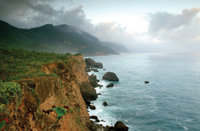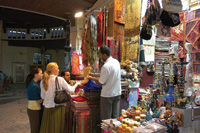
OMAN is looking to boost its booming meetings, incentives, conferences and exhibitions (Mice) business with the setting up of a world-class conference facility at a cost of more than RO400 million ($104 million). The two-million sq m ‘Oman Convention and Exhibition Centre’ will open in the capital’s Baushar district and will boast a 10,000-seat auditorium and four hotels. The complex is expected to be complete in four years with the main facilities ready within two years.
Khaled Al Zadjali, acting director of tourism events, Oman Ministry of Tourism, said: “Oman is fast-emerging as a leading business tourism destination in line with our investments in various hospitality projects and the state-of-the-art conference centre that is being built in the country. The new facility will have a major impact on the country’s economy and will help generate hundreds of jobs as well as attract hundreds of thousands of business travellers each year.”
Situated about four kilometres away from the Muscat International Airport, the centre will be built according to traditional Omani architecture and will consist of banqueting halls, a large shopping mall, meeting hall for 3,000 people, apart from the main auditorium, a sprawling exhibition area, 200 serviced apartments and parking area for 5,500 vehicles. The four hotels will offer a total of 1,000 rooms, it was reported in Khaleej Times.
The project will also incorporate state-of-the-art audio-visual technologies, as “part of the sultanate’s efforts to develop a booming tourism industry that will welcome millions of visitors to the country each year.
 |
As part of government’s plan, called Vision for Oman’s National Economy: Oman 2020, the Ministry of Tourism aims to attract 12 million visitors by 2020. The tourism industry is expected to become one of the largest contributors to GDP by then. The World Travel & Tourism Council (WTTC) expects the industry to grow from 1.5 per cent of total GDP in 2010 to 2.4 per cent of GDP by 2020. The country has also been investing heavily in tourism, especially in infrastructure and airports. Three new airports will be built to boost the industry and the government is spending at least $3.2 billion upgrading its gateway airport, Muscat International Airport.
Oman has been recognised for its array of popular tourist activities including water sports, rock climbing, sand skiing in the desert, trekking, cave exploration, dolphin shows, fishing charters and camel races. The country also boasts hundreds of forts and castles which give it its unique character and age-old charm. Last year the ministry promoted its domestic tourism, with emphasis on local and regional residents and will continue this initiative into 2011. Various promotions with the hotel companies have been lined up for this purpose. “With properties like the new Swiss-Belhotel Resort Masirah Island, the Salalah Marriott Resort and the luxurious Six Senses Zighy Bay in Musandam, we are confident this will see more success,” added Al Zadjali. The country boasts of a number of natural and cultural heritage sites that have become key tourist attractions. Some of them include:
As Saleel Nature Park – The park is located in the Al Kamil and Al Wafi in Oman’s A’Sharqiyah region, 57 kms from the Sur City. Covering an area of 220 sq km, the park is covered with lush forests of acacia trees. It is home to a variety of rare species such as the Arabian gazelle, the Omani wild cat (locally known as Al Senmar). Other fascinating animals have also made this environment their home, including the red fox and the Egyptian eagle.
Al-Dimaniyat Islands Nature Reserve – Located in Wilayat Al Seeb in the Al Batinah region, about 70 kms west of Muscat, the 100 hectare nature reserve is composed of nine islands with white, sandy beaches and crystal blue waters. This reserve has a rich natural heritage and is blessed with several kinds of coral reefs, including some rare varieties, making it ideal for snorkelling. The island is home to a large number of sea turtles that lay their eggs and nest there, as well as migratory and indigenous birds.
Turtle Reserve – The beaches between Ras Al Hadd and Masirah Island in the A’Sharqiyah region are the main stomping ground for a species of rare turtle that returns every year to lay its eggs. Ras Al Jins is a quiet sanctuary for turtles to lay their eggs, securing the continued survival of the species and protecting them from extinction. Visitors to the beach can enjoy the beauty of the beach and view the distinctive tracks left by the turtles. A scientific centre has been established containing illustrative displays of the turtles laying their eggs.
Salalah – Salalah is renowned for its pleasant seasonal weather, and during the Khareef season it is frequented by large numbers of local, regional and international visitors. Salalah’s key tourist attractions include the 30 m long tomb of Prophet Emran, the father of Moses. There is a Unesco World Heritage site for frankincense. Other attractions include the ruins of the ancient cities of Al-Blaid and Samhuram and the springs at Ain Sahnot, Ain Rzat and Ain Hamran.
Sultan Qaboos Grand Mosque – Oman’s Sultan Qaboos Grand Mosque is a truly stunning spectacle. Muscat’s gleaming Sultan Qaboos Grand Mosque spreads over a staggering 40,000 sq m. The prayer hall can accommodate 20,000 worshippers, and is illuminated by a sparkling Swarovski crystal chandelier and a hand-woven Iranian carpet.
Jabrin Castle – Jabrin Castle was built in the late 1600s by Imam Bala’rab bin Sultan Al-Ya’arubi. It is one of a large number of castles and forts in Oman, and is distinguished by its attractive style, as it was originally built as a palace, and later used as a fort. Jabrin Castle is decorated with intricate carvings, painted flowers and symbols. This enormous castle has three floors and 55 rooms, and a tomb of the Imam remains on the premises today.
Bait Al Zubair Museum – Bait Al Zubair Museum is dedicated to showcasing important ethnographic artefacts that reflect the special inherited skills of Oman’s society. Traditional craft industries, once a vital part of the nation’s economy, are now amongst the most important aspects of Oman’s cultural heritage. Bait Al Zubair is the ideal location to view a variety of traditional Omani life. Within its grounds, is a full-scale replica Omani village, souq and irrigation system. In a traditional whitewashed Old Town Muscat dwelling, Bait Al Zubair’s displays include household implements, embroidered costumes and silver khanjars (traditional Omani daggers).
Muttrah Souq – One of the oldest preserved souqs in Oman is Muttrah Souq, which sits cosily under a palm-frond roof in Muttrah. The many winding alleyways burst with stalls selling gifts and trinkets, silverware, spices, clothing and antiques. Gold and silver jewellery is found in abundance as well as numerous wooden carvings, ornaments and spices. Bartering is expected and soon comes naturally, even to first-time visitors.
